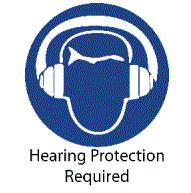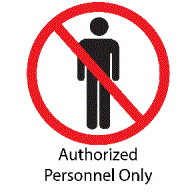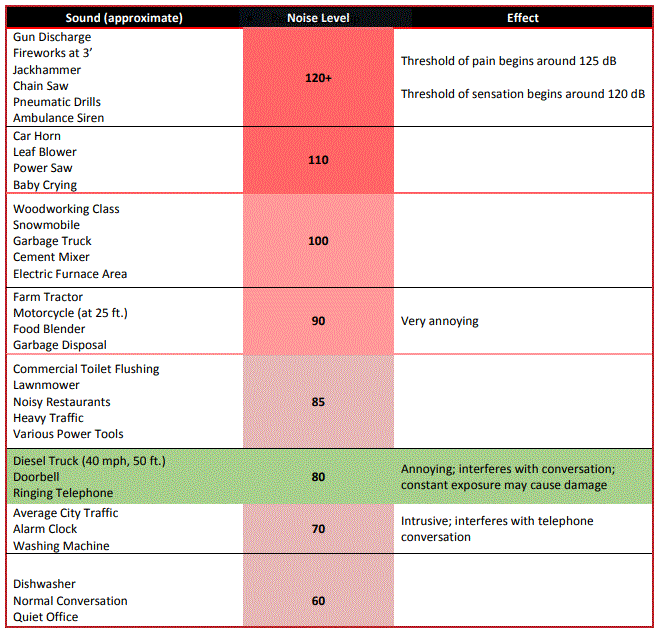Hearing Conservation Program
Download the PDF Version
1.0 Purpose
The purpose of this Hearing Conservation Program is to protect faculty and staff who may be working in environments with noise levels that could temporarily or permanently damage hearing. The program is designed to ensure that monitoring occurs where necessary, and appropriate hearing protection is available with associated training.
The program fulfills Occupational Safety and Health Administration (OSHA) regulatory requirements in 29 Code of Federal Regulations (CFR) 1910.95, Occupational Noise Exposure, along with responsibilities in the Montana State University (MSU) Environment, Health & Safety Policy.
2.0 Scope
This program covers all occupational noise operations within the MSU Bozeman campus as well as locally leased work spaces used by MSU faculty and staff.
Occupational Noise is defined as that which occurs at a high enough decibel rating and/or frequency combination to present a health hazard. See Appendix B, Information on Noise Levels, for information on noise levels.
The primary components of the program are:
• Monitoring;
• Employee Notification;
• Occupational Medical Surveillance;
• Hearing Protection;
• Training; and
• Recordkeeping.
This program does not cover employees engaged in oil and gas well drilling and servicing operations.
3.0 Responsibilities
3.1 Deans, Directors, and Department Heads
Responsible for:
1. Ensuring compliance with this program in their respective areas of responsibility;
2. Ensuring corrective actions are taken to remedy deficiencies identified in their respective areas of responsibility;
3. Stopping and/or complying with SRM requests to cease any activity which presents an unreasonable health or safety risk to employees, students or visitors; and
4. Identifying, and contacting SRM in regards to areas where exposures to loud noises occur.
3.2 MSU Leadership, Managers, Supervisors, Faculty and Principal Investigators (PI)
Responsible for:
1. Ensuring implementation of this program in their areas;
2. Contacting SRM when noise levels within their working area are suspected to be overly loud (the need to shout at conversational distances is a good indicator);
3. Contacting SRM when changes that affect noise levels in a controlled area occur; and
4. Ensuring their employees and students are trained.
3.3 Employees
Responsible for:
1. Complying with this program;
2. Participate in Audiometric Testing as required and offered;
3. Wearing approved hearing protection where required;
4. Attending hearing conservation (on-line or classroom) and site-specific training as required.
3.4 Safety Coordinators (SC)
Responsible for:
1. Coordinating with Deans, Directors, Department Heads, Building Supervisors, and SRM to assist in program implementation; and
2. Using hearing protection and conservation as a topic in periodic safety meetings.
3.5 Safety & Risk Management
Responsible for:
1. Developing and updating this program;
2. Maintaining exposure records associated with audiometric monitoring;
3. Providing general hearing protection training;
4. Providing hearing protection fit assistance and application consult;
5. Providing support in program implementation; and
6. Performing periodic inspections to assist in deficiency identification and correction (including stopping activities which present unreasonable health or safety risk to employees, students or visitors).
3.6 Environment, Safety & Health Committee
Responsible for:
1. Reviewing and recommending adoption of this program.
4.0 Monitoring
The Hearing Conservation Program will be initiated when there has been an identification of potential noise exposure, and monitoring has identified that an action level has been reached.
4.1 Identification of Noise Exposures
Identification of noise exposures is the responsibility of the employer, per OSHA 1910.95. MSU Leadership shall identify any noises that are likely equivalent to or louder than 85 decibels and report these to SRM (994-2711) for evaluation. Sound levels that require yelling at normal conversational distances are a good indicator of elevated sound levels warranting concern. Appendix B, Information on Noise Levels, provides resources for recognizing noise levels. 3 | Page Whenever a change in processes, location, equipment, or other noise generation occurs, MSU Leadership must re-evaluate and contact SRM if the noises are likely equivalent to or louder than 85 decibels.
4.2 Monitoring of Exposure
When an exposure area is determined to be of a sound level high enough to monitor by SRM, SRM will initiate a sampling strategy to identify doses and/or time-weighted averages (TWA). Noise measurements of all continuous, intermittent and impulsive sound levels from 80 decibels (Action Level) to 130 decibels will be integrated into the survey.
4.3 Cost of Identification and Monitoring
The cost of the assessment and monitoring is part of the SRM budget within the Administration and Finance Division.
5.0 Employee Notification
Employees exposed at the 80 decibels Action Level will be notified by SRM of the results of the monitoring program. They will be provided with an opportunity to observe any noise measurements conducted.
If an area is determined to fall within the Action Level, signage will be posted on all entry-ways notifying potential entrants of the requirement to wear hearing protection, as well as it being posted as authorized personnel only, as seen below.


6.0 Occupational Medical Surveillance
Audiometric testing will be implemented whenever employee noise exposures are equal to or exceed an 8-hour time-weighted average sound level (TWA) of 85 decibels measured on the A scale (slow response) or, equivalently, a dose of fifty percent.
6.1 Cost of Occupational Medical Surveillance
The cost of the Occupational Medical Surveillance program is part of the SRM budget within the Administration and Finance Division.
6.2 Testing Health Professional
Testing shall be performed by the occupational medicine provider contracted by SRM for this purpose. The provider will meet all requirements as outlined in 29 CFR 1910.95(g).
6.2.1 Baseline Audiogram
Prior to working in an area that has exposures of an 8-hour time-weighted average (TWA) of 85 decibels or greater, MSU Leadership must direct each employee to SRM for assistance. SRM will work with the employee and supervisor to admit them into the Medical Surveillance program and complete the necessary paperwork. Within 6 months, the employee is required to complete a baseline audiogram with the contracted occupational medicine provider. The employee must not be exposed to workplace noise for at least 14 hours prior to the Baseline Audiogram. SRM approved hearing protection may be used as a substitute for the requirement that baseline audiograms be preceded by 14 hours without exposure to workplace noise. SRM and the occupational medicine provider will notify employees of the need to avoid workplace noise and high levels of non-occupational noise during the 14-hour period immediately preceding the audiometric exam.
6.2.2 Annual Audiogram
At least annually after obtaining the baseline audiogram, if the employee continues to be exposed to workplace noise at or above an 8-hour time-weighted average of 85 decibels, they are required to partake in an audiogram. Employees will be notified by the occupational medicine provider or SRM at least 30 days prior to their examination’s expiration date.
The annual audiogram may be substituted for the baseline audiogram when, in the judgment of the occupational medicine provider:
6.2.2.1 A standard threshold shift (defined in 6.2.3) revealed by the audiogram is persistent; or
6.2.2.2 The hearing threshold shown in the annual audiogram indicates significant improvement over the baseline audiogram.
6.2.3 Threshold Shift
A standard threshold shift is a change in hearing threshold relative to the baseline audiogram of an average of 10 dB or more at 2000, 3000, and 4000 Hz in either ear. An adjustment may be made for the contribution of aging as determined by the occupational medicine provider. If a standard threshold shift occurs at an annual audiogram, the occupational medicine provider will notify the employee and will take appropriate action, as outlined in the hearing conservation section of the Occupational Medical Surveillance manual maintained by MSU’s service provider.
7.0 Hearing Protection
Prior to working in an area that has exposures of an 8-hour time-weighted average of 85 decibels or greater, MSU Leadership must direct each employee to SRM for assistance. At a minimum, SRM will train the employee in proper use of hearing protection.
A variety of options for hearing protection will be made available to the employee to adjust for fit, adequacy, and user preference where possible. SRM will ensure proper initial fitting and training in the use and care of all hearing protection provided to employees. Individuals that have been fitted and trained may receive additional hearing protection and other hearing protection options by contacting SRM at 994-2711.
MSU Leadership is responsible for ensuring that employees necessitating the use of hearing protection as determined by SRM or the occupational medicine provider, wear it at appropriate times and correctly.
8.0 Training
Whenever a non-trained/non-monitored employee is introduced into a controlled area, the supervisor must cease high noise operations, or contact SRM to provide training and hearing protection.
Hearing Conservation training is required at time of initial assignment, annually, and whenever a change in hearing protection is issued. All hearing conservation training is conducted by SRM.
8.1 Training Content
1. The requirements of 29 CFR 1910.95, Occupational Noise Exposure;
2. The effects of noise on hearing;
3. The purpose of hearing protection, the advantages, disadvantages, and attenuation of various types, and instructions on selection, fitting, use and care; and
4. The purpose of audiometric testing, and an explanation of the test procedures.
5. Proper fit of hearing protection.
8.2 Who Must Be Trained
The following employees must be trained in Hearing Conservation:
1. All employees who are exposed to noise at or above an 8-hour time weighted average of 85 decibels; and who
a. Have not yet had a baseline audiogram; or
b. Have experienced a standard threshold shift.
8.3 Training Delivery
Training is delivered in two ways: on-line training, and live classroom training.
8.4 Training Documentation
Training records are maintained by SRM and are available for inspection by contacting SRM at 994-2711.
8.5 Cost of Training
The cost of the Hearing Conservation training is covered within the SRM budget.
9.0 Recordkeeping and Access to Records
9.1 Medical Surveillance Records
Medical Surveillance records are maintained by the contracted occupational medicine provider appointed by MSU.
These records shall be provided upon request to employees, former employees, representatives designated by the individual employee, and the Montana Dept. of Labor & Industry.
9.2 Noise Exposure Measurement Records
Records of noise exposure measurements are maintained by SRM and will be retained for a minimum of 2-years. These records shall be provided upon request to employees, former employees, 6 | Page representatives designated by the individual employee, and the Montana Dept. of Labor & Industry.
9.3 Occupational Noise Standard
29 CFR 1910.95 is available to all employees, their representatives in the following locations:
1. Online on the OSHA Website -
https://www.osha.gov/pls/oshaweb/owadisp.show_document?p_table=STANDARDS&p_id=9 735
2. In print at the SRM office (1160 Research Drive)
Any additional information supplied to MSU by the Montana Dept. of Labor & Industry will be forwarded on to affected employees within 30 days of receipt.
Appendix A: Exclusions
The following are excluded from requirements in this program:
1910.95(o) Paragraphs (c) through (n) of the 29 CFR 1910.95 Occupational Noise Exposure Standard shall not apply to employers engaged in oil and gas well drilling and servicing operations.
Appendix B: Information on Noise Levels
The following list is an approximate guide on the typical decibel (dBA) ratings of various sounds to help guide the MSU Leadership in their interpretation of sound levels in their working areas. If you have any questions, please contact SRM at 994-2711.
Information extracted and modified from;
Center for Hearing and Communication
National Institute on Deafness and Other Communication Disorders

